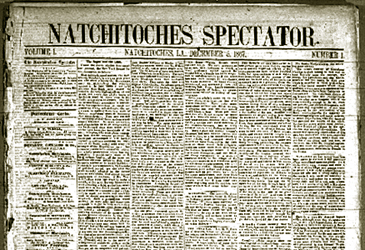New light on an old Louisiana newspaperman
John Milton Scanland must have shaken in his boots when he opened his door one day and stood face to face with a man he thought was dead -- Wyatt Earp.
More than two years earlier, in March 1922, Scanland, a writer for the Los Angeles Times, had published an article about the legendary western lawman best known for his involvement in the gunfight at the O.K. Corral in Tombstone, Arizona. The truth about the fight had become distorted since 1881, when it took place, and Earp's reputation had been tarnished by rumor and false accusations. Rather than as an upholder of the law, Scanland depicted Earp as a bandit and murderer. He even claimed Earp had been killed at Colton, California.
In fact, Earp was alive and well -- and living in Los Angeles. When he opened his copy of the Times and found Scanland's disparaging article, he decided he'd had enough of the lies. Though it took him several years to find the article's author, he eventually tracked him down, intending to give him a piece of his mind. To his surprise, Earp discovered Scanland was an old man like himself who said he had just been trying to make a living. Earp settled for a written apology and retraction of the article's statements. But from then on, he decided, things were going to be different. "Earp buffs everywhere owe Scanland a debt of gratitude," one historian has written. "There can be no doubt that Scanland's garble of historical libel prompted Wyatt to overcome his reluctance to talk about his life."
Who was J. M. Scanland? Research recently conducted for the Louisiana Digital Newspaper Project sheds light on this unwittingly important figure in the history of the American West.
Scanland was born in Mississippi around 1843. Orphaned at a young age, he began his career at the Caddo Gazette in Shreveport, Louisiana, where he and his brother William Henry Scanland, who later rose to prominence as editor of the Bossier Banner, worked as apprentices. After serving in the Confederate army, Scanland edited the Bienville Messenger in Sparta, a small town near Shreveport. There he courted Adele Coleman, daughter of a prominent local planter. Scanland’s reasons for leaving Sparta aren't clear but may have stemmed from Coleman’s rejection of him and marriage to Marshall Harvey Twitchell, a belligerent Carpetbagger from Vermont. Twitchell was later a target of Louisiana's equivalent of the gunfight at the O.K. Corral -- the Coushatta Massacre of 1874. The confrontation left at least 11 men dead because of their political views.
By 1867, Scanland had become editor of the Natchitoches Spectator, a Democratic newspaper. His politics, however, were somewhat ambiguous. When accused of being sympathetic to the Radical Republicans, who had taken over Louisiana after the Civil War, Scanland denied the charges, but in September 1868, he sold the Spectator to Major James Cromie, a Republican officeholder and former commissioner of the local Freedman’s Bureau. Cromie immediately began publishing a Republican newspaper, the Red River News.
Scanland eventually found his way to California, where in the 1880s he edited the Ojai Valley View and the Santa Paula Graphic. Later he wrote articles, mostly on western topics, for various newspapers, including the L.A. Times, which hailed him as "a pioneer California journalist" when he died in 1935. In 1908, in El Paso, Texas (where he was probably working as a news reporter) Scanland published a biography of another western lawman only slightly less famous than Wyatt Earp -- Pat Garrett, the New Mexican sheriff who killed Billy the Kid. Garrett, incidentally, had grown up on a plantation not far from Shreveport. We can only wonder whether he and Scanland crossed paths in their youth.
-- Michael Taylor, Assistant Curator of Books

